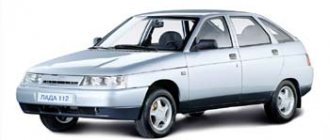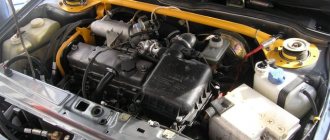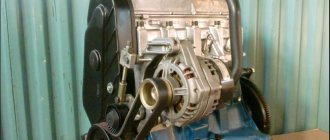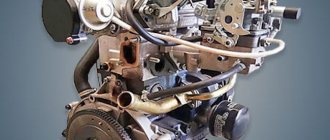After the Volzhsky Automobile Plant began developing a front-wheel drive line of cars, a problem arose, since not a single existing power unit was suitable for installation. And then the engineering department was given the task of developing a motor with fairly small dimensions and weight, which would provide decent power and torque.
After some time, the VAZ 2108 engine appeared, which remained in the hearts of car enthusiasts and enthusiasts for a long time. This was achieved due to the fact that the engine provided enough power and at the same time complied with environmental standards, and also consumed a fairly small amount of fuel.
Specifications
| Engine capacity, cc | 1295 |
| Maximum power, hp | 63 — 68 |
| Maximum torque, N*m (kg*m) at rpm. | 94 (10) / 3500 95 (10) / 3400 |
| Fuel used | Gasoline AI-95 Gasoline AI-92 |
| Fuel consumption, l/100 km | 6.8 — 8.6 |
| engine's type | In-line, 4-cylinder |
| Add. engine information | Carburetor |
| Maximum power, hp (kW) at rpm | 63 (46) / 5600 64 (47) / 5600 68 (50) / 5600 |
| Compression ratio | 9.9 |
| Cylinder diameter, mm | 76 |
| Piston stroke, mm | 71 |
| Number of valves per cylinder | 2 |
Peculiarities
The VAZ 2108 engine block was developed by engineers from the Volzhsky Automobile Plant together with specialists from Porsche. It was intended for installation in a car with front-wheel drive and a 5-speed gearbox. The engine was first introduced in 1984 under the hood of the famous V8.
The power unit received its name from the car model and was used as the basis for the concern’s new, eighth series of engines. The engine continued to be produced until 2004. From time to time, engineers carried out improvements, which led to the appearance of new modifications. Additionally, models were also developed for experiments with a displacement of 1.5 and 1.6 liters with 16 valves.
A deformed modification with a working volume of 1.1 liters was also produced, which was not produced for very long, since it was not widely used. But the 1.5 liter version of the engine gained popularity, so it was produced in two fuel supply options - with a carburetor and an injector.
The engine capacity of the VAZ 2108 is 1.3 liters, and it is a classic naturally aspirated gasoline engine with four cylinders. The power of the VAZ 2108 engine in this configuration is 63 horsepower, and the peak torque is 94 Nm.
The engine was developed with certain requirements, so it differs from others in its small size. Manufacturers managed to achieve such indicators due to the fact that they applied a certain kind of innovative technical solutions:
- The center-to-center distance of the cylinders was reduced to 89 millimeters (for comparison, in classic models they are 95 millimeters).
- The length of the connecting rods was also reduced from 136 to 121 millimeters. Manufacturers also reduced the height of the cylinder block, the length of the valves and the dimensions of the head, and the camshafts and crankshafts became shorter accordingly.
- The design of the oil pump drive has also been modified. It is driven directly from the crankshaft, without accompanying parts.
- The cooling of the VAZ 2108 engine was also redesigned, since the water pump was integrated directly into the cylinder block. In addition, the size of a number of elements of the power unit was reduced.
The engine turned out to be quite economical, which was achieved by improving the combustion chamber, which received an increased compression ratio of up to 9.9 units. Changes in the power system and ignition also played a significant role. At that time, there were already quite stringent environmental requirements, so manufacturers had to make the exhaust less toxic by ensuring high combustion efficiency of the fuel-air mixture.
The engineers also tried, and they managed to significantly reduce the noise during engine operation. This was achieved due to the fact that the balance of the crankshaft was increased. Also, the reduction in vibrations is caused by the use of good quality components. The most striking example is the reduction of clearance in pistons and valves.
The operation of the VAZ 2108 engine was ensured by a classic cast iron block without liners. The surface that is intended for fixing the cylinder head was made with increased rigidity. The cylinder head itself was cast from an aluminum alloy, and was also further strengthened by using stiffeners. The head gasket also received a fundamental change, since it began to be made of non-shrink material, and it also had oil channels with additional sealing.
Manufacturers made pistons from aluminum and equipped them with three rings - two compression rings and one oil scraper ring. The working surface was made of cast iron and was also coated with chrome. As an addition, a ring was installed on the piston for thermal fixation.
The crankshaft was made of cast iron, which contained graphite inclusions. The internal balance of this part was 62 percent. For comparison, on classic engines this figure was 40%.
The valve mechanism also received a fairly large design simplification. Thermal clearances must be adjusted as before - manually using washers, since the design does not provide for the installation of hydraulic compensators. During operation, the valves rotate around an axis, which ensures uniform wear of the part. Unfortunately, the VAZ 2108 8-valve engine was left with an old and well-known problem - when the valve belt breaks, it bends.
The gas distribution mechanism has a belt drive that connects the camshaft and the pump. The generator is driven by its own belt from the crankshaft. The ignition distributor, together with the fuel pump, rotates directly from the camshaft.
The cooling system also remained in the traditional design, since it is made of a closed type and has forced circulation of coolant. There were also no changes in the lubrication system, which only received design changes to the elements and their installation locations shifted slightly. Manufacturers also stated that the engine is not demanding on the quality of oil.
The VAZ 2108 engine number is not difficult to find, since it is stamped on the right side directly on the cylinder block, in close proximity to the thermostat and directly above the clutch housing.
The stock engine can be tuned
The basic model with a volume of 1300 cm³ is tuned by boring the cylinders to a diameter of 79 mm. A piston group from LADA Kalina (including connecting rods) is installed, and you get a new engine model. The volume is 1400 cm³, the power is higher, and the engine becomes lighter. True, there is a problem - the thin walls of the cylinder block contribute to overheating.
Therefore, experienced tuners prefer a different option. The donor is a model with a volume of 1500 cm³. Block 083 is taken and ground down to obtain a volume of 1.4. As a result, the engine does not lose reliability, only the cylinder head changes, and the volume and power increase.
Bottom line: The motor is interesting, both in terms of operation and as a testing ground for experiments. For a thirty-year-old structure, the potential is quite good.
Advantages
The VAZ 2108 1.3 liter engine has received quite wide distribution and a large number of positive reviews. This was achieved thanks to the efforts of engineers, which resulted in a fairly large number of advantages:
- Making changes to the design of the cooling system almost completely eliminated the possibility of overheating (with the exception of breakdowns). Those who have driven a classic know that moving around the city with a fan driven directly from the engine is not entirely comfortable, but now people have not encountered them.
- Repairing the VAZ 2108 engine is as simple as possible, since there were no serious or abstruse elements in its design. This allows you to repair it practically in the field without the need to use specialized equipment.
- The engine was very compact, so cars with it under the hood had a fairly good weight distribution, which contributed to optimal behavior on the road while taking difficult turns at high speed (of course, in comparison with classic models).
- Availability of spare parts. Since this motor has become quite widespread, at the moment you can find almost any parts for it absolutely everywhere. At the same time, additional elements are not expensive.
Briefly about the key components of the G8 carburetor
The Solex 1107010 carburetor, which is installed on the Lada 2108, is an emulsion device with two chambers. It has a cable-actuated throttle body (manual). The lower chamber of the carburetor contains dampers and a float compartment. It also has a housing with special diffusers. The upper chamber has a cover covering the body and fuel fittings. This cover is equipped with studs (they secure the air filter) and a flange.
The Solex 1107010 design provides for a number of key components:
- accelerator pump;
- float device;
- throttle control system;
- forced idle economizer system;
- two chambers and their dosing mechanisms;
- starting device (manually controlled);
- econostat;
- idle system.
In addition, the carburetor has many other mechanisms and individual parts that ensure its stable operation.
Problems
But despite a fairly large number of positive qualities, the carburetor engine of the VAZ 2108 provided its owners with a certain kind of problem. But all this could be eliminated simply, which did not cause any difficulties:
- The motor can cause inconvenience with floating speeds. The main reason for the unstable operation of the engine is the carburetor from the Solex company. It needs to be cleaned regularly, as well as repaired and adjusted, so you will have to learn how to do it yourself or find the appropriate service.
- The engine may stall due to the components of the ignition system. You immediately need to pay attention to the distributor cap, and if this does not help, then you need to start inspecting the spark plugs and high-voltage wires.
- Despite changes to the cooling system, the engine may overheat. There are several main reasons for this problem - a coolant leak may occur, or the thermostat and fan may fail.
- Oil leaks may appear in the engine, and the weakest points where they form are the valve cover gaskets. As a rule, such a problem can be dealt with in a trivial way - simply by replacing the gasket with a new one.
- Increased volume during operation, which in most cases is caused by the lack of proper adjustment of the thermal clearances on the valves. Less often this happens due to detonation. If everything is fine with the valve adjustment, then you should check the ignition, or change the gas station.
- The VAZ 2108 engine protection is located very low, so when driving over rough terrain you should be as careful as possible, since there is a high probability of breaking through the pan, which will lead to loss of oil.
Reliability, weaknesses, maintainability
Reliability
During factory tests, the VAZ-2108, and later in wide operation, proved to be reliable and economical, stable in operation. High-quality assembly, the use of reliable components and parts is confirmed by the fact that the units of early releases operate reliably to this day.
At various specialized forums, car owners share their impressions of the engine. The vast majority of reviews are positive.
For example, Vladimir from Krasnodar writes the following: “... over 23 years of operation, it has traveled more than 500,000 km and is now on the move. On the negative side: oil was leaking from under the timing cover and I had to change the heater radiators and cooling system - I filled it with low-quality antifreeze...”
Den from the Zaporozhye region speaks of his long-liver as follows: “... the engine has never had major overhauls (but the rings and pistons have been changed), the condition of the cylinder walls is ideal, the fuel consumption is frankly pleasing, although the car is 22 years old...”.
All car owners, without exception, emphasize the importance of timely and quality service. And they emphasize that only in this case the engine will serve flawlessly.
Dmitry from Moscow says on this topic: “... mileage 175,000 km, starts with half a turn. The car never failed. I would like to give advice to respected car enthusiasts: if you want your iron comrade to serve you faithfully for many years, treat it with respect...”
Reliability is convincingly demonstrated by the fact that the resource declared by the manufacturer is exceeded by more than three times.
The safety margin indicator is of no small importance.
Tuning VAZ-2108
The engine can be boosted to 200 hp. With. True, to the detriment of the resource. Here it’s not for everybody – either the original engine will last for a long time, or a particularly powerful one, but for a short time.
Thus, the reliability of the VAZ-2108 is beyond doubt.
Weak spots
Immediately after leaving the assembly line, car owners discovered several weak new engines.
- The valve cover required modification because its gasket often failed.
- A low resource of the cooling system components was noted. Particularly annoying were the water pump and connecting hoses, which required frequent replacement.
- Engine detonation. The reason for its occurrence was low-quality fuel. The slightest deviation in this matter, in addition to detonation, caused clogging of the carburetor.
- The Solex carburetor turned out to be quite capricious in operation. Particularly annoying was the need to frequently adjust the idle speed and clean it. Subsequently, the Solex was replaced by a more efficient Ozone carburetor.
The occurrence of other problems was a periodic occurrence. Almost all of them are directly or indirectly related to violations by the car owner.
For example, leakage of oil or coolant from under the seals. It is enough to detect the malfunction in time and fix it immediately. Or loud engine operation. The phenomenon is unpleasant, but it is enough to adjust the valves or set the ignition and the problem disappears. Often, saving on fuel (low-octane refueling) contributed to the appearance of detonation, and therefore unnecessary noise.
Overheating of the engine could be caused by a faulty thermostat or electric fan of the cooling system. In the case of constant monitoring of the operating temperature of the internal combustion engine by the driver, engine overheating is excluded.
Despite the existing shortcomings, we can conclude that they do not exceed the critical threshold in comparison with the motors previously produced by the plant.
Dimensions
The dimensions of the VAZ 2108 engine are its main advantage, since it was developed with the need to achieve maximum compactness for installation in front-wheel drive vehicles. The length of the motor is 540 millimeters, the width is 422 millimeters, and the height is 561 millimeters. Also, many people wonder how much the VAZ 2108 engine weighs, and the answer to it is quite simple - the weight of the engine is 127 kilograms. These are pretty good indicators, since the weight is much less than that of classic power units.
Modifications
Despite the fact that the VAZ 2108 carburetor engine had a fairly large number of positive qualities, the engineers decided to make certain changes to its design. Thus, one of the modifications of the power unit appeared:
- Engine VAZ 21080 - this modification is structurally practically no different from the standard model, only its volume now began to be exactly 1300 cubic centimeters. It also met increased requirements of environmental standards, which led to increased demands on fuel quality.
What models was the VAZ used in?
The 2108 engine was installed on the VAZ Samara (export) and Sputnik (for the domestic market) models:
- 2108;
- 2109;
- 21099.
ICE 2108 in nine
Deformed internal combustion engines with a volume of 1.1 liters and 1.5 liter engines, the boosting of which was carried out by the VAZ manufacturer at the factory, were installed exclusively on the VAZ 2108 Samara. volumes
Maintenance
Since the engine has a transverse arrangement, its maintenance and timing are somewhat different from classic models. The timing belt must be replaced after 100 thousand kilometers so that there are no surprises later with its breakage and bent valves.
The VAZ 2108 engine mount (support) must be replaced after 150 thousand kilometers, otherwise you may encounter various kinds of problems in the form of increased vibrations during movement, as well as quite loud noise during operation.
Since the design does not provide for the installation of hydraulic compensators, the thermal clearances are adjusted manually using washers. This procedure must be performed once every 20 thousand kilometers.
New oil must be added to the VAZ 2108 engine every 10 thousand kilometers. Just keep in mind that these are general recommendations, so if you move with increased loads, then you should reduce the mileage from replacement to replacement.











